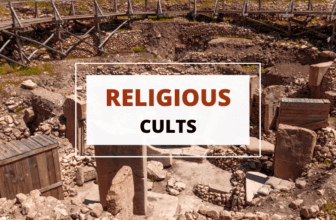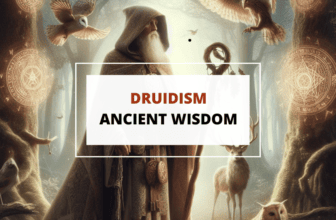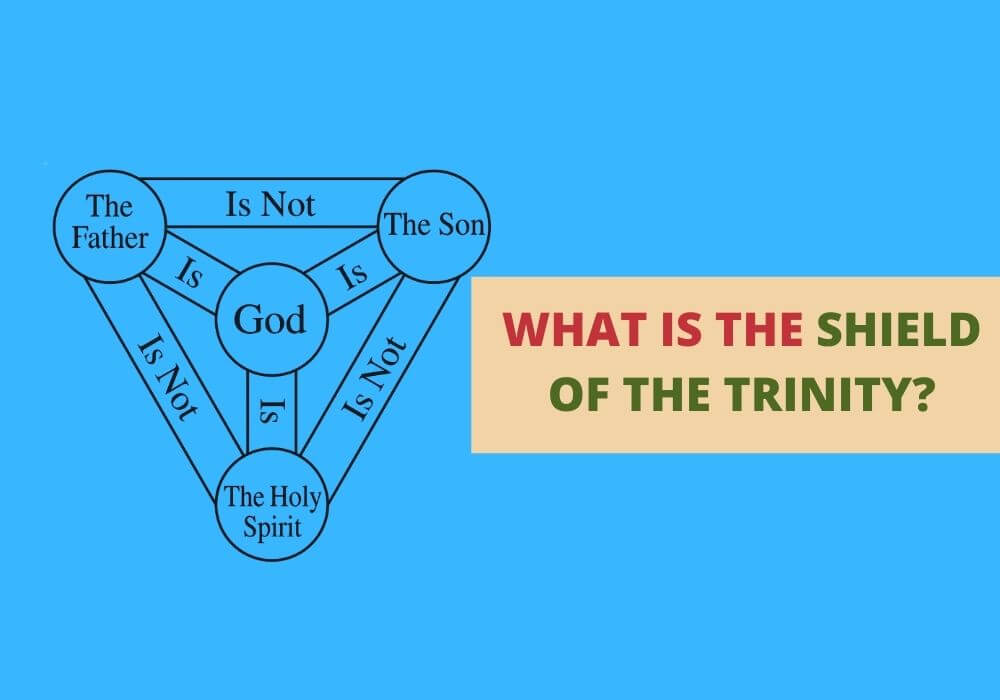
Table of Contents
The Shield of the Trinity is a symbol that’s fascinated both believers and scholars. It’s a visual representation of Christianity’s complex Trinity doctrine, packed with mystery and deep theological meaning.
Let’s take a look at its origins and what it really stands for, seeing how it’s influenced religious thinking and stayed a key symbol of faith over time.
What is the Shield of Trinity?
The Shield of the Trinity, or Scutum Fidei, is a key Christian symbol that breaks down the Holy Trinity doctrine, showing God as three distinct yet united entities: the Father, the Son (Jesus Christ), and the Holy Spirit.
This symbol uses a shield or diagram with three Latin labels, “Pater,” “Filius,” and “Spiritus Sanctus,” all linked to the center, “Deus,” to show each one is God. It also uses “non est” outside the links to make it clear that, although all are God, they are not the same as each other—for instance, the Father is not the Son.
Dating back to the early medieval times, the Shield of the Trinity visually captures the idea of unity within the Trinity, highlighting the distinctiveness yet equality in divinity and essence of the Father, Son, and Holy Spirit.
Christians have long used this diagram to explain and defend the Trinity doctrine, tackling misconceptions and heresies with a simple but impactful representation of a deep Christian belief.
Variations of the Shield of Trinity Symbol
Throughout history, the Holy Trinity was expressed in many ways. In church architecture we often see three arches or pillars. People bless themselves with a sign of a cross with three fingers joined together to show their respect and faith in the Trinitarian God. Christians have used different symbols and designs to express the Holy Trinity and the nature of the God, and here are some of them:
1. The Shield of the Trinity
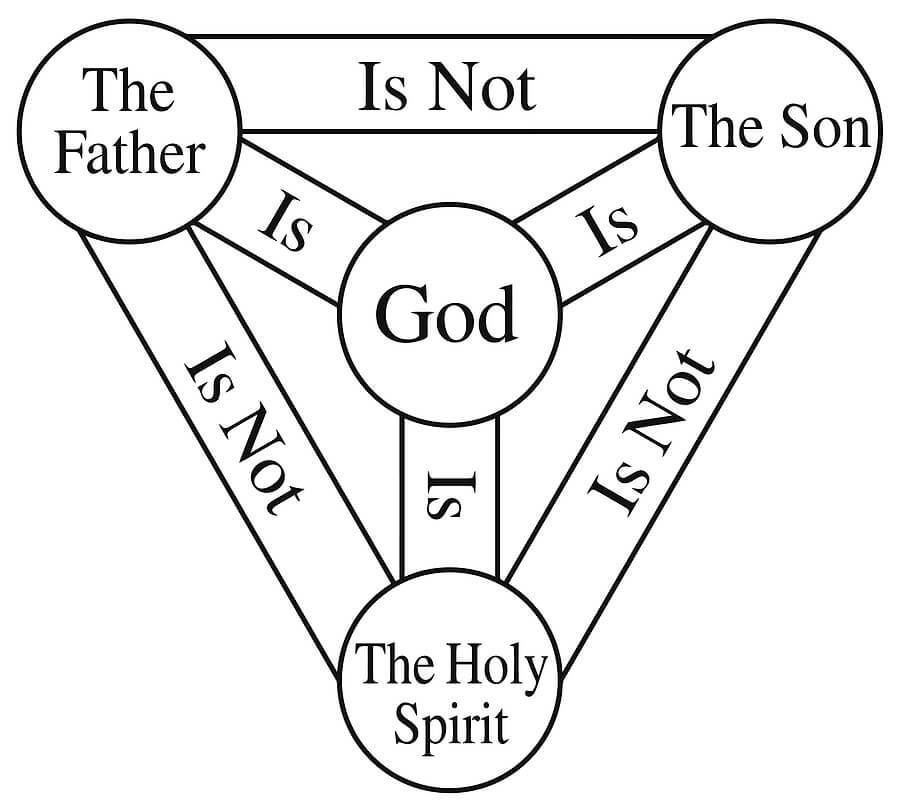
The classic Shield of Trinity symbol dates back to the 12th century and is shaped as a downward-pointing triangular diagram.
It consists of four interlinked circular nodes. The three nodes are at each vertex of the triangle connected with three same-length bars. The fourth node or circle is placed in the center and is also linked with bars of equal length to the outer circles. The three names are written inside the circles at the edge of the diagram – The Father (Latin Pater), The Son (Latin Filius), and The Holy Spirit (Spiritus Sanctus). The circle at the center has God (Deus) written inside it.
The three links connecting the inner with the outer circles carry the word ‘is’ (Latin Est), while the bars connecting the outer circles are labeled with ‘is not’ (Latin Non Est).
The Shield is a Christian traditional visual symbol that expresses different aspects of the Trinity doctrine. The beautiful organization of words and sentences within the diagram represents the everlasting nature of the God and God’s activity in the world.
2. Triangle
One of the earliest symbolic representations of the Holy Trinity was an equilateral upward-pointing triangle.
The three equal sides with equal angles represent the three persons in one God. It’s extremely strong shape convey the balance and stability of the Godhood. The connection between each side of the triangle represented the eternal nature of the Trinity.
3. Circle
The three entwined circles represent the three unified members of the Trinity. As a never-ending line with no beginning and no end, a circle represents perfection, eternity, or God.
4. Borromean Rings
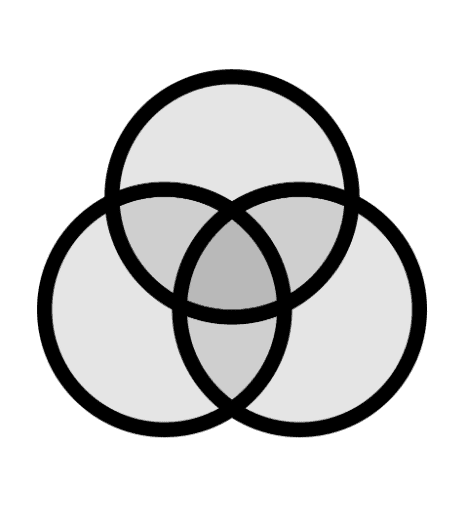
The interlaced Borromean golden rings are used to represent the idea of the Trinity unity and the worship of one God. The earliest source of the rings can be traced back to the 13th-century manuscript found in the Municipal Library at Chartres. Inside the center, at the intersection of all the circles, the word ‘unitas’ was written, and the syllables ‘tri-ni-tas’ were distributed in the outer sectors.
5. Trefoil
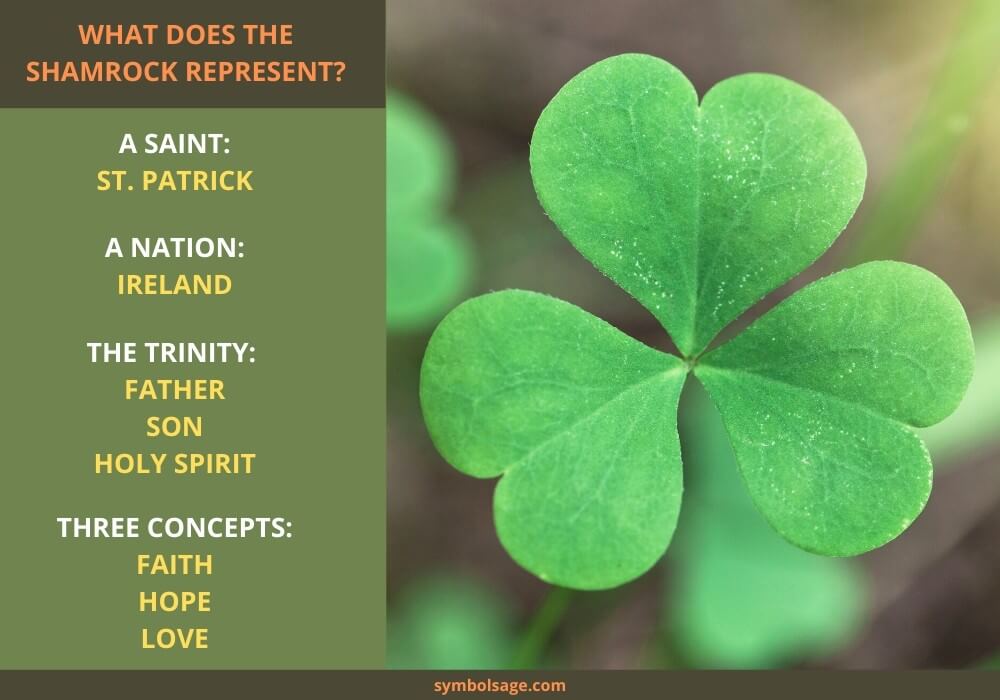
Trefoil is one of the most common symbols of the Trinity, often found in Gothic church windows. It depicts a three-leafed shamrock created and used by St. Patrick to illustrate Trinity’s doctrine and unity – the three separate leaves of one clover-like plant.
6. Fleur-de-lis
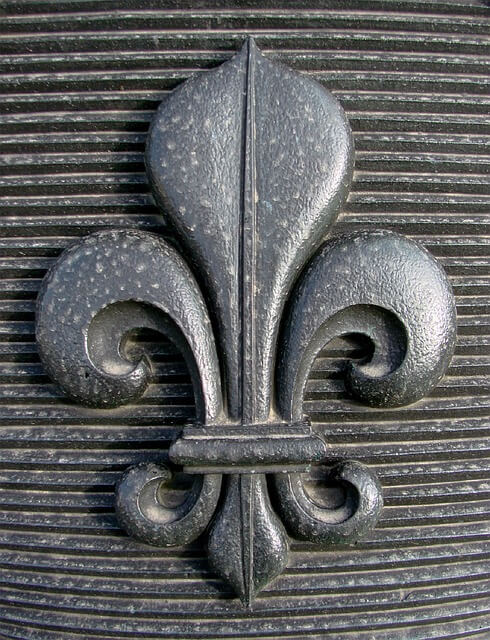
This stylized lily or iris symbol is used to represent several ideas. One tradition claims that Fleur-de-lis symbolizes the tears shed by the Mother of Jesus, or the Virgin Mary, after his crucifixion, and hence, represents purity. The French kings adopted it as a symbol of royalty. Due to its shape of three equal parts, it also depicts the Holy Trinity.
7. Triquetra
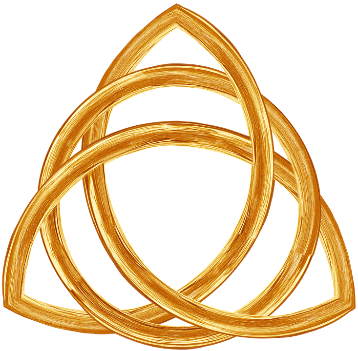
The Triquetra, or Trinity Knot, is an early Trinity symbol design based on the oldest Christ symbols, the shape of three fish. The interweaving of the three equal arches of the circle represents indivisibility. All of the arches are of the same length, which is symbolic of the equality of the Father, the Son, and the Holy Spirit. Finally, the continuous line that makes the shape of the Triquetra represents eternity.
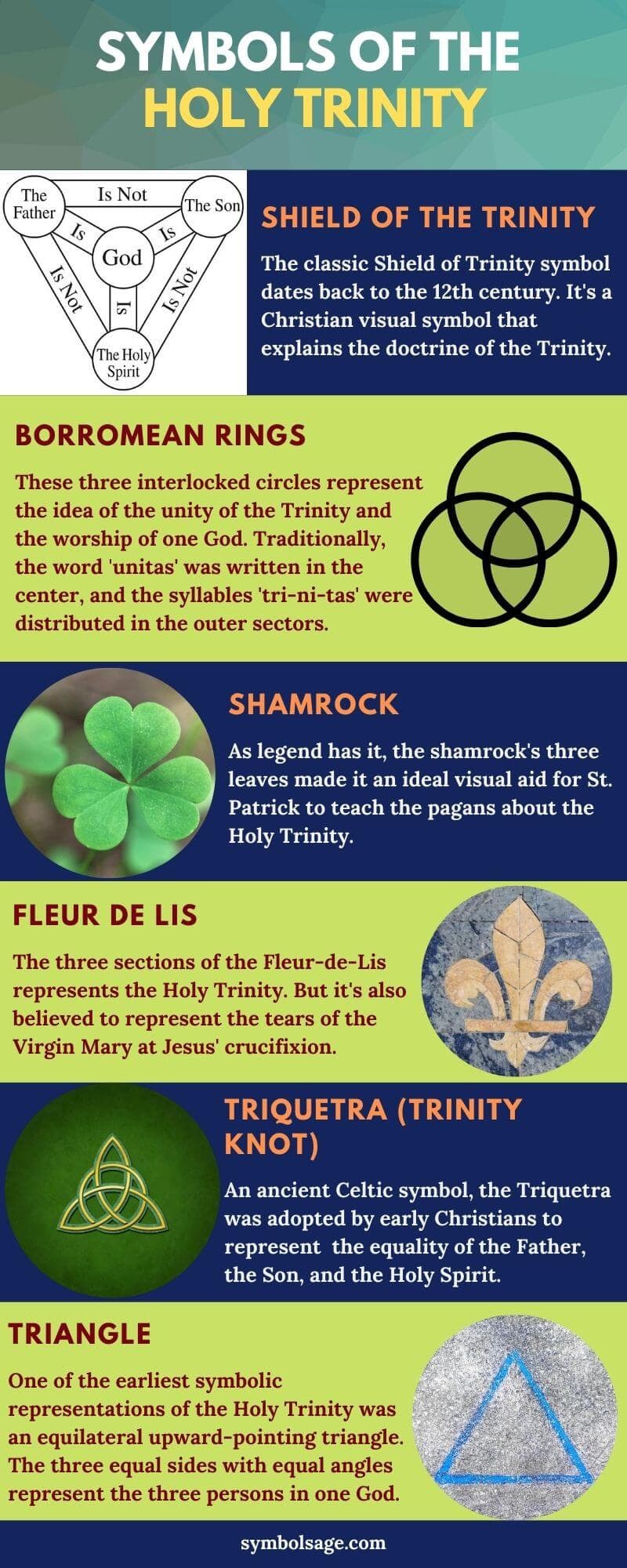
The Meaning of the Shield of Trinity Symbol
The Shield of Trinity emblem beautifully captures the deep meaning of the Holy Trinity, showing how the Father, the Son, and the Holy Spirit are completely divine, united, yet uniquely different. Its design, with links that can be followed in any direction, highlights how these three entities are closely connected, different but made of the same stuff, always together, and involved in everything divine—from creating to saving to blessing.
Right at the core of Christian belief, the Trinity doctrine shows us the real nature of God and how reality itself is shaped in a triadic form, symbolizing eternal unity, and indivisibility. This idea of three distinct aspects coming together as one emphasizes ongoing connection and the life-giving links among all things.
The Holy Trinity even extends metaphorically to represent the family (with roles like husband, wife, and child), our complete human experience (tying together our thoughts, actions, and feelings), and the values that last forever (like faith, love, and hope).
This makes the Scutum Fidei not just a key theological symbol but also a universal sign that reflects the complex layers of life and faith, painting a picture of eternity and the tight bond between the past, present, and future.
Non-Christian Interpretations of the Trinity Symbol
The Holy Trinity concept triggers mixed reactions across religions. Islam sees it as evidence that Christianity has strayed from the true monotheism, moving away from the worship of the one God, Allah. The Qur’an presents a ‘trinity’ of God, Jesus, and Mary, which doesn’t match the Christian Trinity.
On the flip side, some religions see the Trinity idea in a more positive light and find similar concepts in their beliefs. Hinduism, for example, has the Trimurti, showing three forms of God that resonate with the supreme Brahman’s qualities of absolute truth, consciousness, and bliss, echoing a ‘threefold’ theme.
Researchers have found the trinity idea in ancient religions across the globe, showing its longstanding significance. Sumerians divided the universe into three parts; Babylonians worshiped a three-headed god; Indians honored Brahma, Vishnu, and Shiva as a powerful trio.
Aristotle from Greece noted that “everything and all things are bounded by threes,” pointing to the importance of beginning, middle, and end.
Egyptians celebrated Amun, Re, and Ptah; and Paganism had the Triple Goddess, representing the maiden, mother, and crone. These instances show how the concept of three holds a universal appeal, cutting across different cultures and religions.
The Shield of Trinity Symbol in Modern Age
Today, the Shield of Trinity symbol still plays a big role in Christian circles, visually breaking down the Holy Trinity’s complex relationship. You’ll see it in religious art, books, and buildings, highlighting its key role in Christian thought and worship.
It works great as a teaching tool, making the tricky concept of the Trinity clearer for followers by showing how the Father, Son, and Holy Spirit are both united and unique. Beyond just religious uses, the symbol has also made its way into pop culture and modern design, showing off its broad appeal and versatility.
The Shield of Trinity stands as a strong symbol of faith, togetherness, and the divine mystery, connecting with people who want to get a deeper grasp of Christian teachings and God’s nature as the world keeps changing.
Wrapping Up
With such a wide array of different meanings, the symbolism of the Shield of Trinity is open to interpretation but its most common association is as a representation of the concept of the Holy Trinity in Christianity. The various meanings it can have boil down to one common eternal concept of the three interconnected entities – separate, but, yet, dependent on one another.






